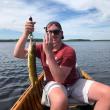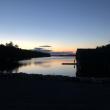A Grand (Lake Stream) Adventure at Weatherby’s
 As a Father’s Day gift, Jeff and his son spent a few days at the historic Weatherby’s sporting camp in Downeast Maine. Courtesy of Jeff Wells
As a Father’s Day gift, Jeff and his son spent a few days at the historic Weatherby’s sporting camp in Downeast Maine. Courtesy of Jeff Wells
 Jeff and his son enjoyed fly fishing on the famed Grand Lake Stream. Courtesy of Jeff Wells
Jeff and his son enjoyed fly fishing on the famed Grand Lake Stream. Courtesy of Jeff Wells
 Both fishermen made it into Weatherby’s 20” Club with huge pickerel, though the younger of the two landed the bigger fish, 21 inches! The fish were quickly released back. Courtesy of Jeff Wells
Both fishermen made it into Weatherby’s 20” Club with huge pickerel, though the younger of the two landed the bigger fish, 21 inches! The fish were quickly released back. Courtesy of Jeff Wells
 Although fishing was the primary activity during the trip, the adventurers enjoyed hearing the songs of northern parulas, blue-headed vireos, thrushes, and other birds. They especially enjoyed hearing the melancholy yodel of a common loon from the dock on West Grand Lake at sunset. Courtesy of Jeff Wells
Although fishing was the primary activity during the trip, the adventurers enjoyed hearing the songs of northern parulas, blue-headed vireos, thrushes, and other birds. They especially enjoyed hearing the melancholy yodel of a common loon from the dock on West Grand Lake at sunset. Courtesy of Jeff Wells
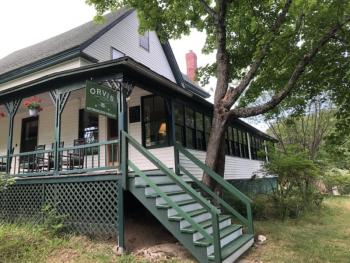 As a Father’s Day gift, Jeff and his son spent a few days at the historic Weatherby’s sporting camp in Downeast Maine. Courtesy of Jeff Wells
As a Father’s Day gift, Jeff and his son spent a few days at the historic Weatherby’s sporting camp in Downeast Maine. Courtesy of Jeff Wells
 Jeff and his son enjoyed fly fishing on the famed Grand Lake Stream. Courtesy of Jeff Wells
Jeff and his son enjoyed fly fishing on the famed Grand Lake Stream. Courtesy of Jeff Wells
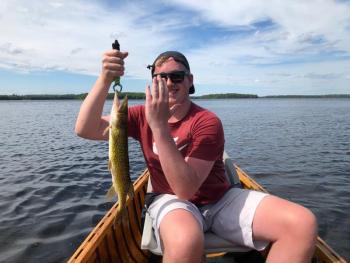 Both fishermen made it into Weatherby’s 20” Club with huge pickerel, though the younger of the two landed the bigger fish, 21 inches! The fish were quickly released back. Courtesy of Jeff Wells
Both fishermen made it into Weatherby’s 20” Club with huge pickerel, though the younger of the two landed the bigger fish, 21 inches! The fish were quickly released back. Courtesy of Jeff Wells
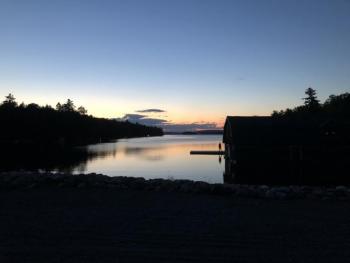 Although fishing was the primary activity during the trip, the adventurers enjoyed hearing the songs of northern parulas, blue-headed vireos, thrushes, and other birds. They especially enjoyed hearing the melancholy yodel of a common loon from the dock on West Grand Lake at sunset. Courtesy of Jeff Wells
Although fishing was the primary activity during the trip, the adventurers enjoyed hearing the songs of northern parulas, blue-headed vireos, thrushes, and other birds. They especially enjoyed hearing the melancholy yodel of a common loon from the dock on West Grand Lake at sunset. Courtesy of Jeff Wells
For Father’s Day, I sent Jeff and our son Evan on a fishing adventure Downeast. This is Jeff’s recount of that adventure. —Allison Wells
Once again it was the time of year when being a father can mean that special things can come the way of us dads. For Father’s Day this year, I received a very special gift from Allison. It involved a three-hour drive with our soon-to-be-headed-to-college son to a place a scant 15 miles from the Canadian border and a 45-minute drive from the border crossing at Calais.
We went to the tiny community of Grand Lake Stream, where we spent a few days at the historic Weatherby’s sporting camp. Grand Lake Stream flows from West Grand Lake about three miles to Big Lake. A small community was formed here originally around a tannery in the late 1800s. The tannery operated for several decades but finally closed down in 1898. One of the early buildings built for one of the tannery bosses was on a hill overlooking the stream and lake. By about 1901, the owners of the house and some surrounding cottages began hosting people who would come from some distance (even from Boston and New York) for fishing and hunting in the Maine Woods. Local guides became a traditional part of the experience throughout Maine around this time, and Grand Lake Stream was no exception. Although it didn’t become known as Weatherby’s until the 1930s, the lodge and surrounding cottages have continued operating now for more than a hundred years, with the traditional Maine Guide service and great food being part of the draw.
The fishing here has been equally famous since even before the days of sporting camp. Adventurers came up and tented out to catch the landlocked salmon, and lake and brook trout. Those species still continue to be one of the biggest reasons people come. Grand Lake Stream itself has been only fly-fishing (no spin fishing allowed) for more than a hundred years and people absolutely love to come specially to fly-fish the stream. I had not been fly-fishing since my high school years, and our son had never tried it (though has been an avid spin fisherman for a long time), so one priority was to get some fly-fishing lessons and experience from one of Weatherby’s accomplished guides.
We enjoyed an ample breakfast at the lodge (socially distanced appropriately at the tables, with the staff wearing masks and taking all precautions). Then we stepped outside and met Deryn, our guide, at what we learned was the famous “Liar’s Bench” where guides have been telling their fish stories for a century. After a quick lesson with the fly rod in the backyard, we were down to the bubbling, crystal clear stream (only a few hundred yards away), already floating flies into the cool water. Birds were not the main attraction on this adventure but the songs of northern parula warblers, American redstarts, and blue-headed vireos kept us company from the nearby woods. Later a female common merganser, gray-bodied with a brown scraggly crest, nervously led her four downy chicks upstream past us.
We succeeded in catching a brook trout and a small landlocked salmon (both quickly released) before breaking for a guide-cooked lunch over a fire, which included meat, potatoes, pickles, and the secret recipe for “guide’s coffee,” a smooth but robust jolt of caffeine to keep us going through the afternoon.
After lunch, Deryn unveiled one of the famous Grand Laker canoes with a square stern and brought us out onto nearby Big Lake. Here we used more conventional spinning rods and reels with lures and caught more smallmouth bass and pickerel then we thought possible; most were bigger than any we had every caught before! The flutey songs of hermit thrushes and Swainson’s thrushes drifted out across the water from the shore as we drifted in our canoe catching and carefully releasing fish after fish.
The calories we burned off through the afternoon were replaced back at the lodge that evening with a delightful four-course meal (served by friendly face-mask wearing staff) that included carrot ginger soup, savory pork chops, and lemon yogurt cake. Later we strolled down by the dock on West Grand Lake to enjoy the sunset. In the half light, a hen common goldeneye scuttered away from the shore with her brood of three or four chicks in tow. A loon yodeled in the distance. We listened, and then walked quietly back to our cabin for the night. It was a special time of fishing and bonding over an activity we both enjoy, in a place that is incredibly beautiful. It was a trip we will never forget.
Jeffrey V. Wells, Ph.D., is a Fellow of the Cornell Lab of Ornithology and Vice President of Boreal Conservation for National Audubon. Dr. Wells is one of the nation's leading bird experts and conservation biologists and author of “Birder’s Conservation Handbook”. His grandfather, the late John Chase, was a columnist for the Boothbay Register for many years. Allison Childs Wells, formerly of the Cornell Lab of Ornithology, is a senior director at the Natural Resources Council of Maine, a nonprofit membership organization working statewide to protect the nature of Maine. Both are widely published natural history writers and are the authors of the book, “Maine’s Favorite Birds” and “Birds of Aruba, Bonaire, and Curaçao: A Site and Field Guide” from Cornell Press.
Event Date
Address
United States







